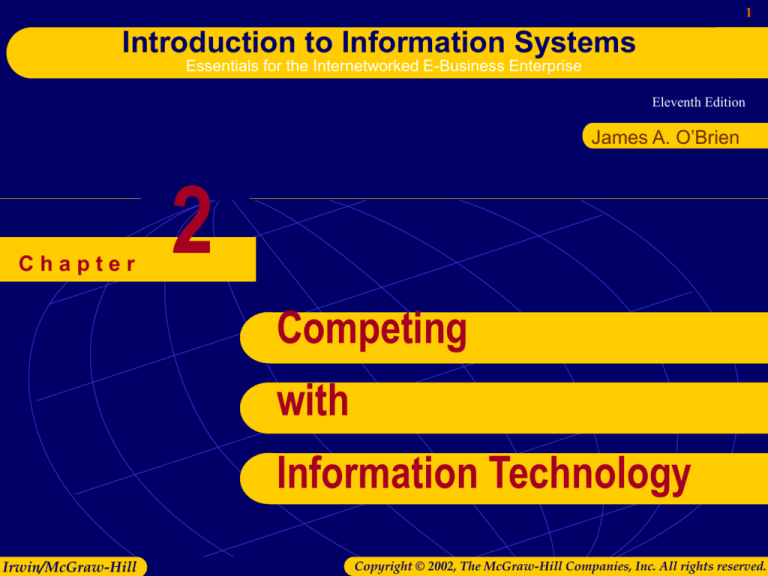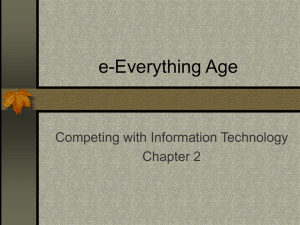
1
Introduction to Information Systems
Essentials for the Internetworked E-Business Enterprise
Eleventh Edition
James A. O’Brien
Chapter
2
Competing
with
Information Technology
Irwin/McGraw-Hill
Copyright © 2002, The McGraw-Hill Companies, Inc. All rights reserved.
James A. O’Brien
Introduction to Information Systems
Eleventh Edition
2
Chapter Objectives
• Identify several basic competitive strategies
and explain how they can use information
technologies to confront the competitive forces
faced by a business.
• Identify several strategic uses of information
technology for electronic business and
commerce, and give examples of how they give
competitive advantages to business.
• Give examples of how business process
reengineering frequently involves the strategic
use of e-business technologies.
Irwin/McGraw-Hill
Copyright © 2002, The McGraw-Hill Companies, Inc. All rights reserved.
James A. O’Brien
Introduction to Information Systems
Eleventh Edition
3
Chapter Objectives
• Identify the business value of using e-business
technologies for total quality management, to
become an agile competitor, or to form a virtual
company.
• Explain how knowledge management systems
can help a business gain strategic advantages.
Irwin/McGraw-Hill
Copyright © 2002, The McGraw-Hill Companies, Inc. All rights reserved.
James A. O’Brien
Introduction to Information Systems
Eleventh Edition
4
The Competitive Environment
Bargaining Power
of Suppliers
Threat of
New
Entrants
Rivalry Among
Existing
Competitors
Threat of
Substitutes
Irwin/McGraw-Hill
Bargaining Power
of Customers
Copyright © 2002, The McGraw-Hill Companies, Inc. All rights reserved.
James A. O’Brien
Introduction to Information Systems
Eleventh Edition
5
Fundamental Competitive Strategies - Cont.
Cost Leadership Strategies
Differentiation Strategies
Innovation Strategies
Growth Strategies
Alliance Strategies
Irwin/McGraw-Hill
Copyright © 2002, The McGraw-Hill Companies, Inc. All rights reserved.
James A. O’Brien
Introduction to Information Systems
Eleventh Edition
6
Strategic Uses of Information Technology
Strategy
IT Role
Outcome
Irwin/McGraw-Hill
Improving
Business
Process
Use IT to
reduce costs
of doing
business
Enhance
Efficiency
Promote
Business
Innovation
Use IT to
create new
products or
services
Create New
Business
Opportunities
Locking in
Customers
and Suppliers
•Use IT to
improve quality
•Use IT to link
business to
customers and
suppliers
Maintain Valuable
Customers and
Relationships
Copyright © 2002, The McGraw-Hill Companies, Inc. All rights reserved.
James A. O’Brien
Introduction to Information Systems
Eleventh Edition
7
Strategic Uses of Information Technology
Strategy
IT Role
Outcome
Irwin/McGraw-Hill
Raise
Barriers
to Entry
Increase
amount of
investment or
complexity of
IT needed to
compete
Increase
Market Share
Build a
Strategic IT
Platform
Leverage
investment in
IS resources
from operational uses to
strategic uses
Create New
Business
Opportunities
Build a
Strategic
Information Base
Use IT to
provide
information to
support firm’s
competitive
strategy
Enhance
Organizational
Collaboration
Copyright © 2002, The McGraw-Hill Companies, Inc. All rights reserved.
James A. O’Brien
Introduction to Information Systems
Eleventh Edition
8
The Value Chain
Administrative Coordination & Support Services
Human Resource Management
Technology Development
Procurement of Resources
Inbound
Outbound
Operations
Logistics
Logistics
Irwin/McGraw-Hill
Marketing
Customer
and
Service
Sales
Copyright © 2002, The McGraw-Hill Companies, Inc. All rights reserved.
James A. O’Brien
Introduction to Information Systems
Eleventh Edition
9
The Internet Value Chain
Internet
Capability
Marketing and
Product
Research
Benefits
to
Company
Data for
market
research,
establishes
consumer
responses
Opportunity
for
Advantage
Irwin/McGraw-Hill
Increase
Market Share
Sales and
Distribution
Support and
Customer
Feedback
•Low cost
distribution
•Reaches new
customers
•Multiplies
contact points
•Access to
customer comments online
•Immediate response to
customer
problems
Lower
Cost Margins
Enhanced
Customers
Satisfaction
Copyright © 2002, The McGraw-Hill Companies, Inc. All rights reserved.
James A. O’Brien
Introduction to Information Systems
Eleventh Edition
10
Strategic Positioning of Internet Technologies
High
Global Market
Penetration
Product and Services
Transformation
Strategy
E-Commerce Website
Value-added IT Services
E-Business; Extensive
Intranets and Extranets
Solution
Cost and
Efficiency
Improvements
Performance
Improvements in
Business
Effectiveness
E-Mail, Chat Systems
Low
Intranets and Extranets
E-Business Processes Connectivity
Internal Drivers
Irwin/McGraw-Hill
High
Copyright © 2002, The McGraw-Hill Companies, Inc. All rights reserved.
James A. O’Brien
Eleventh Edition
Introduction to Information Systems
11
Customer-Focused e-Business
Let customers
place orders
directly
Let customers
check order history
and delivery status
Build a
community
of customers,
employees,
and partners
Let customers
place orders thru
distribution
partners
Customer
Database
Transaction
Database
Give all
employees a
complete view
of customers
Irwin/McGraw-Hill
Link Employees
and distribution
partners
Copyright © 2002, The McGraw-Hill Companies, Inc. All rights reserved.
James A. O’Brien
Introduction to Information Systems
Eleventh Edition
12
Business Reengineering and Quality Management
Business Quality
Improvement
Definition
Target
Potential
Payback
Risk
What Changes?
Primary
Enablers
Irwin/McGraw-Hill
Business
Reengineering
Incrementally Improving
Existing Processes
Radically Redesigning
Business Systems
Any Process
Strategic Business
Processes
10%-50% Improvements
10-Fold Improvements
Low
High
Same Jobs - More Efficient Big Job Cuts; New Jobs;
Major Job Redesign
IT and Work Simplification
IT and Organizational
Redesign
Copyright © 2002, The McGraw-Hill Companies, Inc. All rights reserved.
James A. O’Brien
Introduction to Information Systems
Eleventh Edition
13
The Customer- Focused Agile Competitor
Anticipation of
future needs
Cooperate with
Business Partners
and Competitors
Customization
Give Customers
Solutions
to Problems
Conformance
Organize to
Master
Change
Leverage the
Impact of
People and
IS Resources
Irwin/McGraw-Hill
Copyright © 2002, The McGraw-Hill Companies, Inc. All rights reserved.
James A. O’Brien
Introduction to Information Systems
Eleventh Edition
14
Virtual Corporations
Adaptability
Borderless
Excellence
Six
Characteristics
of Virtual
Companies
Technology
Trust-Based
Opportunism
Irwin/McGraw-Hill
Copyright © 2002, The McGraw-Hill Companies, Inc. All rights reserved.
James A. O’Brien
Eleventh Edition
Introduction to Information Systems
15
Knowledge Management Systems
Solution
Knowledge
Technical
Support
Staff
Customers
Development
Engineers
Intranet
Product
Managers
Irwin/McGraw-Hill
The
Internet
Other
Vendors
Copyright © 2002, The McGraw-Hill Companies, Inc. All rights reserved.
James A. O’Brien
Introduction to Information Systems
Eleventh Edition
16
Chapter Summary
• Information systems can play several strategic
roles in business.
• The Internet, intranets, extranets, and other
Internet-based technologies can be used
strategically for e-business and e-commerce
that provide a competitive advantage.
• A key strategic use of Internet technologies is
to build an e-business which develops its
business value by making customer value its
strategic focus.
Irwin/McGraw-Hill
Copyright © 2002, The McGraw-Hill Companies, Inc. All rights reserved.
James A. O’Brien
Introduction to Information Systems
Eleventh Edition
17
Chapter Summary (cont)
• IT is a key ingredient in reengineering business
operations, by enabling radical changes to
business processes that dramatically improve
their efficiency and effectiveness.
• IT can be strategically used to improve the
quality of business performance.
• A business can use IT to help it become an
agile company, that can respond quickly to
changes in its environment.
Irwin/McGraw-Hill
Copyright © 2002, The McGraw-Hill Companies, Inc. All rights reserved.
James A. O’Brien
Introduction to Information Systems
Eleventh Edition
18
Chapter Summary (cont)
• Forming virtual companies has become
an important competitive strategy in
today’s dynamic global market.
• Lasting competitive advantages today
can only come from innovative use and
management of organizational knowledge
by knowledge creating companies and
learning organizations.
Irwin/McGraw-Hill
Copyright © 2002, The McGraw-Hill Companies, Inc. All rights reserved.






